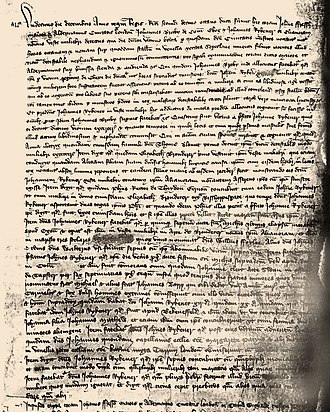
Back John/Eleanor Rykener Spanish John Rykener French John/Eleanor Rykener ID Eleanor Rykener Dutch John Rykener Portuguese John Rykener Turkish

John Rykener, also known as Eleanor,[note 1] was a 14th-century sex worker arrested in December 1394 for performing a sex act with John Britby, a man who was a former chaplain of the St Margaret Pattens church,[2] in London's Cheapside while wearing female attire. Although historians tentatively link Rykener, who was male, to a prisoner of the same name, the only known facts of the sex worker's life come from an interrogation made by the mayor of London. Rykener was questioned on two offences: prostitution and sodomy. Prostitutes were not usually arrested in London during this period, while sodomy was an offence against morality rather than common law, and so pursued in ecclesiastical courts. There is no evidence that Rykener was prosecuted for either crime.
Rykener spoke of being introduced to sexual contact with men by Elizabeth Brouderer, a London embroideress who dressed Rykener as a woman and may have acted as procurer. According to the court transcription of this account, Rykener had sex with both men and women, including priests and nuns. Rykener spent part of summer 1394 in Oxford, working both as a prostitute and as an embroideress, and in Beaconsfield had a sexual relationship with a woman. Rykener returned to London via Burford in Oxfordshire, working there as a barmaid and continuing with sex work. On returning to London, Rykener had paid encounters near the Tower of London, just outside the city. Rykener was arrested with Britby one Sunday evening in women's clothes, and was still wearing them during the interrogation on 11 December. There, Rykener described prior sexual encounters in great detail. But it appears that no charges were ever brought against Rykener; or at least, no records have been found suggesting so. Nothing definite is known of Rykener after this interrogation; Jeremy Goldberg has tentatively identified as the same person a John Rykener imprisoned by and escaping from the Bishop of London in 1399.
Historians of social, sexual and gender history are especially interested in Rykener's case because of what it reveals about medieval views on sex and gender. Goldberg, for example, views it firmly in the context of King Richard II's quarrel with the city of London—although he has also questioned the veracity of the entire record, and posited that the case was merely a propaganda piece by city officials. Historian James A. Schultz has viewed the affair as being of greater significance to historians than more famous medieval stories such as Tristan and Iseult. Ruth Mazo Karras—who in the 1990s rediscovered the Rykener case in the City of London archives—sees it as illustrating the difficulties the law has in addressing things it cannot describe. Modern interest in John/Eleanor Rykener has not been confined to academia. Rykener has appeared as a character in at least one work of popular historical fiction, and the story has been adapted for the stage. Rykener's persistent use of women's clothing and presentation as an embroideress, prostitute, or barmaid has prompted some contemporary scholars to suggest that Rykener was a trans woman.
- ^ Dinshaw 1999, p. 101.
- ^ Janin, Hunt (1 October 2009). Medieval Justice: Cases and Laws in France, England and Germany, 500-1500. McFarland. ISBN 978-0-7864-4502-8.
Cite error: There are <ref group=note> tags on this page, but the references will not show without a {{reflist|group=note}} template (see the help page).
© MMXXIII Rich X Search. We shall prevail. All rights reserved. Rich X Search